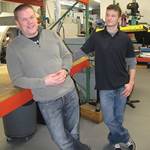Baklund R&D is a job shop that recently added a production 3D printer, as this article describes. Here is more of what shop owner Jon Baklund has learned about additive manufacturing and how to use it effectively:
1. Make a part before winning the job. So long as there is room within the 3D printer, adding an extra piece in the build cycle does little to affect cycle time. One piece or several pieces are built with the same number of layers. Therefore, the shop often produces parts for prospective customers without being asked. If the 3D printer is running anyway, then the shop will call up the model for a part that is out for bid and add it to the cycle. Sometimes taking this initiative works out very well. A prospect that needs components quickly might turn into a customer on the spot, asking the price for that piece. Mr. Baklund can then begin the business relationship on a positive footing by offering a deep discount on that initial unit.
2. Make extras. A strategy the shop sometimes employs with its CNC machines is even easier with additive manufacturing. In many production runs, the shop makes extra pieces to be held in storage for the customer at no cost. Knowing they have these parts in stock allows customers to put off their ordering decisions until the last minute—a choice that favors Baklund R&D because at that point, no other shop can fill the order. Again, in 3D printing, adding extra pieces adds little extra time, so the shop looks to run as many pieces within each additive manufacturing production cycle as it can.
3. Have fun. Because Mr. Baklund expects the shop to serve customers across design, development and production, he hopes for staff members to span the same breadth. The shop’s employees should feel equally comfortable whether they are modeling a part in CAD or producing the part on a machine tool. He says one result of this aim is that he tends to hire younger, inexperienced employees who have no preconception that invention and manufacturing are supposed to be separate spheres. The 3D printer is great for engaging the attention and imagination of the sorts of employees who can thrive in this environment, he says. The machine is a serious and significant production resource that might well represent the future of the company, but at the same time, it is also an outlet for creativity. No matter how busy the machine gets, it is likely that a certain small share of the parts it produces will always be the result of some staff member’s curiosity or frivolity.
Related Content
-
3D printers are getting bigger, faster and smarter. But don’t overlook the other equipment that the AM workflow requires, nor the value of finding the right supplier.
-
“Digital materials” resulting from engineered flexible polymer structures made through additive manufacturing are tunable to the application and can be tailored to the head of the wearer.
-
Successfully matching the performance of a standard basketball demonstrates the control possible over the mechanical properties of digital materials.








